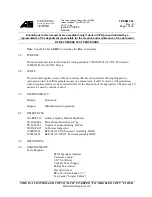
Engine Control System 1A-39
• “Sympton Diagnosis Chart” contain information on
a system that may not be suppored by one or more
DTCs. Sympton Diagnosis Chart verify proper
operation of the system. This will lead the
technician in an organized approach to
diagnostics.
5. Refer to related descriptions such as those for
engine mechanicals.
DTC Stored
Follow the designated DTC chart exactly to make an
effective repair.
No DTC
Select the symptom from the “Sympton Diagnosis
Chart”. Follow to the diagnostic paths or suggestions to
complete the repair. You may refer to the applicable
components/system check in the functional check.
No Matching Symptom
1. Analyze the complaint.
2. Develop a plan for diagnostics.
3. Utilize the wiring diagrams and the theory of
operation.
Call technical assistance for similar cases where repair
history may be available. Combine technician
knowledge with efficient use of the available service
information.
Intermittents
Conditions that are not always present are call
intermittents. To resolve intermittents, perform the
following steps.
1. Observe history DTCs, DTC modes, and engine
data.
2. Evaluate the symptoms and the condition
described by the customer.
3. Use a check sheet or other method to identify the
circuit or electrical system component.
No Trouble Found
This condition exists when the vehicles is found to
operate normally. The condition described by the
customer may be normal. Verify the customer
complaint against another vehicle that is operating
normally. The condition may be intermittent. Verify the
complaint under the conditions described by the
customer before releasing the vehicle.
1. Reexamine the complaint.
When the complaint cannot be successfully found
or isolated, a re-evaluation is necessary. The
complaint should be re-verified and could be
intermittent as defined in Intermittents, or could be
normal.
2. Repair and verify.
After isolating the cause, the repairs should be
made. Validate for proper operation and verify that
the symptom has been corrected. This may involve
road testing or other methods to verify that the
complaint has been resolved under the following
conditions:
• Conditions noted by the customer.
• If a DTC was diagnosed, verify a repair by
duplicating conditions present when the DTC
was set as noted by Tech 2 data.
Verifying Vehicle Repair
When the electronic control system has been repaired,
it is necessary to verify the repair is appropriate. If the
repair is incomplete, the CHECK ENGINE lamp (MIL)
may be lit again while the vehicle is released, or the
drivability may be impaired. Particularly for the
intermittents, it is necessary to reproduce the trouble
under the same conditions described by the customer
and check the trouble is no longer found.
No.
Item
Objective
Method
1
Verifying the
DTC
To check the DTC is not set
after the repair.
Clear the previous DTC. Sufficiently warm up the
engine under idling, and increase the engine
speed to 2200 rpm and provide racing to verify
the test conditions.
2
Verifying the idle
speed after
warm-up
To check the idle control is
normally performed.
Upon completion of engine warm-up, verify the
idle speed is 575 rpm for a manual transmission
vehicle or 640 rpm for an automatic transmission
vehicle with the air conditioner turned off. If a fault
is detected, refer to "Instable idling" in "Sympton
Diagnosis Chart" to identify the cause.
3
Verifying Tech 2
data list
To provide basic checking for
engine control and
communication conditions.
Monitor Tech 2 data list and examine the data
using typical value sheet. Check typical values in
Tech 2 data list.
4
Verifying the
restartability
To check the start control
correctly works.
Upon completion of engine warm-up, verify the
cranking time is not more than 5 seconds and the
engine speed is stable after startup.
Summary of Contents for 4HL1
Page 267: ...No LG4HL WE 0229DOM...
















































